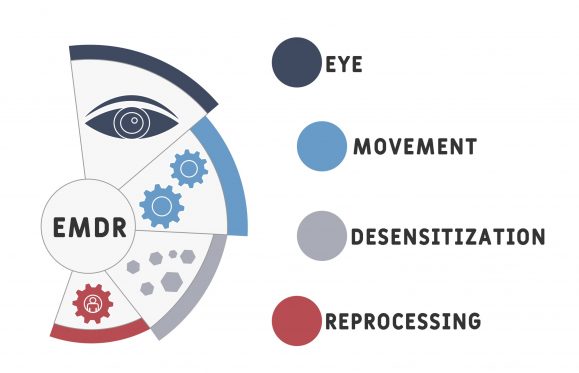
Sonja Beacham
Excellence Within
COUNSELLING & PSYCHOTHERAPY IN NOTTINGHAM AND ONLINE
EMDR
Eye Movement Desensitisation reprocessing
“This EMDR is magic…!”
Esly Regina Carvalho
Changing the memories that form the way we see ourselves also changes the way we view others.
Therefore, our relationships, job performance, what we are willing to do or are
able to resist, all move in a positive direction.
Francine Shapiro. Developer of EMDR
What is EMDR therapy?
Eye Movement Desensitisation and Reprocessing Therapy (EMDR) is an extensively researched and evidenced based psychotherapy. It was introduced by Francine Shapiro, a Psychologist, in the late 1980’s and the aim of the therapy is to identify and process traumatic and other distressing experiences and memories that continue to cause disturbance for the individual.
Psychological trauma hinders communication between our thinking and feeling brains as a way of protecting itself from the traumatic memory. This means the memory isn’t processed as it normally would be and becomes ‘stuck’.
Left to right eye movements help to process this ‘stuckness’ as both sides of the brain are active. A part of the brain known as the corpus callosum, which connects one side of the brain to the other also becomes
active.
What happens when you are traumatised?
Most of the time your body manages information and experiences without you being aware of it. However, when something out of the ordinary happens and you are overwhelmed, your natural coping mechanism can become overloaded.
Trauma can be in many forms – it may be something big you witness such as a death, a natural disaster, a crime or an accident. There are other experiences which can leave your brain traumatised such as abuse, bullying, neglect, and abandonment.
At the time of a traumatic event, strong emotions interfere with our ability to completely process the experience and one moment becomes ‘frozen in time’. Recalling the traumatic event may feel as though the person is reliving the event all over again, as the images, smells, sounds and feelings are still there and can be triggered in the present. When activated, these memories cause a negative impact on our daily functioning and interfere with the way we see ourselves and our world, and how we relate to others.
Sometimes, the memory itself is forgotten, but the painful feelings such as anxiety, panic, anger or despair are triggered.
The analogy between the brain and a computer which is not working properly is effective – all the files, programmes and folders are there, but there is a glitch or a bug which is causing the computer to not function correctly. EMDR therapy will repair the damaged files and restore connections.

How does EMDR therapy work?
EMDR therapy utilises the natural healing ability of your body. It involves recalling a stressful past event and ‘reprogramming’ the memory in the light of a positive, self-chosen belief, while using rapid eye movements to facilitate the process. The eye movements are similar to those during REM sleep. This movement will be created by following the therapist’s finger backwards and forwards or by hand taps to the body ,some therapists use a light bar, handset or headphones. Eye movements will last for a short time and you will be asked to report back on the experiences you have had during those eye movements. Then follows repetition of this process aiming for reduction in symptoms. EMDR does not require talking in detail about the distressing issue or completing homework between sessions. Rather than focussing on changing the emotions, thoughts, or behaviours resulting from the distressing issue, it allows the brain to resume its natural healing process and work to resolve unprocessed traumatic memories in the brain.
There are 8 phases of EMDR therapy:
Phase 1: History and treatment planning
Phase 2: Preparation
Phase 3: Assessment
Phase 4: Desensitisation
Phase 5: Installation
Phase 6: Body Scan
Phase 7: Closure
Phase 8: Re-evaluation
During treatment you will remain in control, fully alert and wide-awake – this is not a form of hypnosis and you can stop the process at any time.
Reprocessing is usually experienced as something that happens spontaneously, and new connections and insights are felt to arise quite naturally from within.
What can EMDR be used for:
● Anxiety, panic attacks, and phobias ● Chronic Illness and medical issues ● Depression and bipolar disorders ● Dissociative disorders ● Eating disorders ● Grief and loss ● Pain ● Performance anxiety ● Personality disorders ● PTSD and other trauma and stress related issues ● Sexual assault ● Sleep disturbance ● Substance abuse and addiction ● Violence and abuse
How long does treatment take?
EMDR therapy can be a brief focussed treatment or used as part of a longer psychotherapy programme.
The number of sessions will vary, depending on the individual needs and to ensure the full EMDR therapy process is achieved. for some clients EMDR therapy can be completed in fewer sessions than other psychotherapies.
How will I feel after my session?
The nature of EMDR therapy means that after your session the treatment will continue to be active in your awareness. This means that you may find yourself thinking about the thoughts you focussed on during processing, so it is important that you give yourself time to rest and relax after a session. You will be fully resourced with relaxation and grounding techniques. It is important you discuss your feelings with your therapist at the next session. Over time, feelings will become less intense. Clients report feeling relief and lighter after sessions.
Benefits of EMDR therapy
Feeling calmer and more able to deal with life
Being able to live life without scare of being triggered
Feeling less distracted and tense/hyper vigilant
Feeling safer
Less loneliness
Memories and flashbacks less traumatic
Improved confidence and esteem
Lowered anxiety and panic
Being more present in relationships
Feeling happier and confident
How effective is EMDR therapy?
EMDR therapy is a proven clinical treatment which has been rigorously researched.
Ongoing research supports positive clinical outcomes showing EMDR therapy as a helpful treatment for many disorders (Maxfield, 2019).
EMDR therapy has even been superior to Prozac in trauma treatment (Van der Kolk et al., 2007). Shapiro and Forrest (2016) share that more than 7 million people have been treated successfully by 110,000 therapists in 130 countries since 2016
EMDR is recommended by the National Institute for Health and Clinical Excellence (NICE) and the World Health Organisation (WHO) as an effective treatment for PTSD.
EMDR is safely and effective to work with online remotely.
“Not only does healing occur much more rapidly than in traditional therapy, but as a result of EMDR’s clearing of emotional and physical blockages, many people also experience a sense of joy, openness, and deep connection with others. EMDR is a quantum leap in the human ability to heal trauma and maladaptive beliefs”
Laurel Parnell - Author of, Transforming trauma with EMDR




